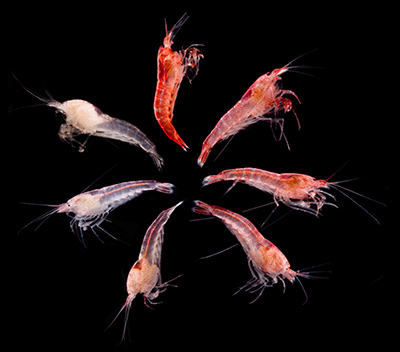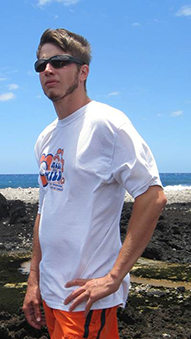Exploring how a volcano changes the environment—and the animals inside it
By Derek Herscovici ’14

From overhead, you would think you were looking at the surface of the moon. Craggy, rock-strewn and pockmarked with craters, it’s inconceivable to think life could survive, let alone thrive out here.
Yet one alumnus not only found life here, but life found nowhere else in the world.
In November 2019 Justin Havird ’14, an assistant professor in the Department of Integrative Biology at the University of Texas at Austin, was exploring a part of Hawaii with a team of researchers that was recently formed by the eruption of the Kilauea volcano in 2018. The cooled magma from the volcano had created acres of new coastline — a rare type of habitat ideal for their work.
Called anchialine habitats, these ecosystems are pools, ponds and caves that are coastal — meaning they’re close to the sea — but without any surface connection to the ocean. Instead, porous volcanic rock creates underground connections between both salt and fresh water and the surface. Found in only a handful of places around the world, Hawaii has the largest concentration of anchialine habitats thanks to its high volcanic activity.
Havird and his team were ostensibly out collecting a species of small red shrimp commonly found in these habitats in order to establish a research colony at the University of Texas. His team included Ryan Weaver ’18, an alumnus currently working as an NSF postdoctoral fellow with Havird. After collecting on Oahu and Maui, they were finishing up on the big island at a site they had gone to many times before.
Just south of Hilo, a black-sand beach contains an anchialine pool that used to be an excellent collection site, but since the volcanic eruption, the shrimp have disappeared. A lot else has also changed, said Havird.
“It was really remarkable, because the pond we usually sampled was spitting distance from the ocean, but when we went there this time, that same pond is a football field’s length away from the ocean.” Amidst the black rubble sand, they noticed new ponds that had formed close to the coastline. They found the shrimp in these new ponds, but, more excitingly, they also found a thin, microbial mat growing around its rim.
The discovery of these alien-like growths, and the effect they have on the shrimp who graze on them, was what drove Havird to apply for and receive a grant from the National Science Foundation.
“Some ponds have really thick, almost fluorescent orange mats made up of algae and bacteria; those communities are found nowhere else in the world, and we were the first to characterize what microbes are there using molecular techniques. I thought it was a great opportunity to study how these communities come into being and how they change over time, which is a process called ‘ecological succession.’”
Part of Havird’s grant money will be used to determine where the shrimp in the new ponds come from. Across the Hawaiian Islands, the shrimp is described as a single species, but they’re actually incredibly genetically diverse. Havird believes they could be classified as seven or eight different cryptic species.
“It’s unclear whether the shrimp in these new habitats are from the same lineage that used to be in the old habitat right next door, or if they’ve colonized these new habitats from somewhere else.”
Havird is building on the research first established at Auburn University 15 years ago by professor Scott Santos, Havird’s onetime Ph.D. advisor and now collaborator. As a child growing up in Hawaii, Santos was intimately familiar with the shallow ponds and the shrimp who inhabited them. Later, as a scientist, he theorized that, given enough time and isolation from each other, the shrimp would begin to take on divergent characteristics.

“[Santos] initially collected shrimp from all these different aquifers all over the islands, then used molecular mitochondrial barcoding techniques to show that, sure enough, these shrimp are wildly different from each other, even though at the surface they look to be pretty similar. The genes betray that they’ve been diverged for really long amounts of time.”
Published on the cover of the Biological Bulletin is a picture from Havird’s work showing the color diversity of the shrimp from near-translucent to bright, blood red.
Theories about the shrimp’s genetic divergence range from “neutral evolution,” where their natural isolation brings about new traits or behaviors, to adaptation for specific temperatures and salinities, which can vary among ponds.
Another theory lies within the microbial “mat,” which has been shown to be composed of at least 1,500 microbial species. The mat is also composed of distinct layers, each having a signature-like color: orange, pink and green.
“We’re doing work to see if shrimp grazing on the microbial community changes its species composition. We’re also looking into what microbes are found in the guts of these shrimp to see exactly what they’re eating.”
Havird and his team were supposed to return to Hawaii in May, but the COVID-19 Pandemic put a stop to it. While much of their work is conducted in the field, Havird and his team have been able to work remotely by analyzing data sets they have already collected. For the time being, they are relying on collaborators still on the islands to provide samples, hoping to find the secrets to this one-of-a-kind ecosystem.
“I’d be really excited if this thin, kind of drab-looking microbial community we’re seeing in these new habitats becomes the bright-orange crust characteristic of other habitats,” said Havird. “If that happens, it’ll only be the third time this community has ever formed, and it would also show that these habitats are a lot more complex than we thought they were.

Auburn Alum and NBC Entertainment Correspondent, Chloe Melas, is Making News
A meeting at Auburn’s student-run television station launched Chloe Melas’ career as an entertainment news correspondent for VH1, CNN and NBC news.
Alum and Military Veteran, Curtis Pippin, Answers the Call
Life isn’t easy in the military, but transitioning out can be even harder. Curtis Pippin ’17 helps veterans adjust to civilian life one connection at a time.
Why Auburn Grads Are Hired By ESPN
When ESPN needs talent in the production room or in front of the camera, it turns to Auburn
Auburn Alum and NBC Entertainment Correspondent, Chloe Melas, is Making News
A meeting at Auburn’s student-run television station launched Chloe Melas’ career as an entertainment news correspondent for VH1, CNN and NBC news.
Alum and Military Veteran, Curtis Pippin, Answers the Call
Life isn’t easy in the military, but transitioning out can be even harder. Curtis Pippin ’17 helps veterans adjust to civilian life one connection at a time.
Why Auburn Grads Are Hired By ESPN
When ESPN needs talent in the production room or in front of the camera, it turns to Auburn


